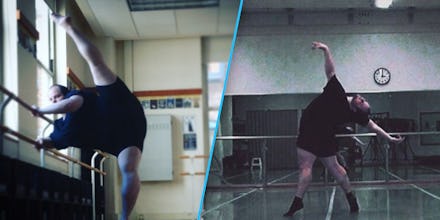Meet the Plus-Size Dancer Who's Proving Body Positivity Knows No Gender

Erik Cavanaugh never expected his pirouetting and chasséing across an empty dance studio would go viral across the internet, nor did he upload the videos with that ever crossing his mind. But this is exactly what happened Sunday when the New York Post posted a compilation of his videos to its Facebook page.
Why did it end up garnering over 3 million views and over 34,000 shares and counting? Besides his obvious talent, Cavanaugh doesn't have the body that many might expect to see leaping and twirling around a studio.
"Not everyone sees me as a dancer," he said in a phone interview. "It's been a struggle."
The 23-year-old, who started dancing his sophomore year of high school, has been faced with the challenge of proving to everyone that he can be just as skilled as any other dancer regardless of being plus size.
"Erik had to transfer from one or two different dance schools before he found a place that took him seriously," his older brother Ryan said in an email. "Because of his weight, dance teachers wouldn't progress him through the programs, just keep him in the same level."
The popular image of a dancer — one of a thin, athletic (but not too muscular) build with no excess fat — has been set, accepted and maintained by the dance community for decades. George Balanchine, who co-founded the New York City Ballet in 1948, has been credited by many for perpetuating this image.
"Standards have been set. You have to look a certain way," Kathryn Morgan, a former NYCB soloist said in a phone interview. "You start to analyze every part of you because you have to fit in the costume. It's your job... it's a business."
This is no different for male dancers. They have to be able to able to lift up and partner with female ballerinas, which is likely why famous male dancers, like Rudolf Nureyev and Mikhail Baryshnikov, had a specific narrow, muscular frame.
Cavanaugh's body does not adhere to this image. When he began applying to college, his tenacity was put to the test when he was not accepted into any schools. Discouraged, but not entirely unphased, he did not give up. After reapplying to Slippery Rock University's dance program and being accepted, Cavanaugh began posting his videos to Instagram.
Since the New York Post feature, Cavanaugh's videos have been inundated with commenters lauding him with praise and admiration. "You are amazing, you inspired me to start dancing again and made me realize why I love to dance," one person wrote on Instagram. "Thank you so much for inspiring me to push myself even harder than I think I can," said another.
Like with any internet sensation, Cavanaugh has opened himself up to the social media's ridicule. "A lot of people are say how inspiring it is, how I'm a good dancer," he said. "[But] I've seen some of the negative comments where people are making fun of my weight or trying to do low blows at me but I don't let that affect me and I don't really care to read them."
Unlike the female body, which is often praised and celebrated — especially as of late with a multitude of body positive campaigns and plus-size models — there is still for the most part one traditional image of a man that floods commercials and magazine covers.
"Most of the time that you see a male model, he's going to be physically fit, toned, masculine man and not someone who look like me," Cavanaugh said. "The male body isn't as publicized as the female body is. There's not enough male presence in the world that show men can be different sizes and shapes."
Read more: This Plus-Size Ballerina Defies All Ballet Stereotypes
As Mic reported in March, a British study found that 81% of men referred to their bodies in self-deprecating terms that "promote anxiety," versus 75% of women.
"The focus on celebrity male athletes' bodies, especially in advertisements, play a key role in promoting an ideal male body image," D. Lynn O'Brien Hallstein, an associate professor of rhetoric at Boston University, said in an email. "Most men have neither the time nor resources required to meet contemporary male body ideals."
With no known professional plus-size male dancers to look to for inspiration, Cavanaugh has been forced to find his own path to success, and through it, discovered his size as not an obstacle, but a source of pride. "The dance world is very clean cut in what they want," he said. "Dance can be beautiful — even with people's 'flaws'."
And the dance world has responded with open arms. "Dance is for everyone, just like music," said James Whiteside, Principal Dancer, American Ballet Theatre. "When someone challenges the norm, it takes courage. Erik's story is a wake up call for people who want to dance, but are afraid of being mocked."
But this is no fluke. "He isn't an overnight sensation," his brother Ryan said. "Erik has put in years of training with dance and years of frustration of being treated differently and being told that his body image wouldn't fit the dance world. But he didn't give up."
Cavanaugh hopes to appear in music videos, dance for a company, choreograph, teach and own his own studio. More importantly, he wants teachers, companies and society in general to open their minds to up and stop labeling dancers or believe they must have a certain body type in order to be talented.
"I want other children who look like me to pursue dance [even if] they don't fit into the image. But not just dance, any sport or any activity," he said. "I want them to see that they are capable of doing whatever their heart desires, no matter what they look like."